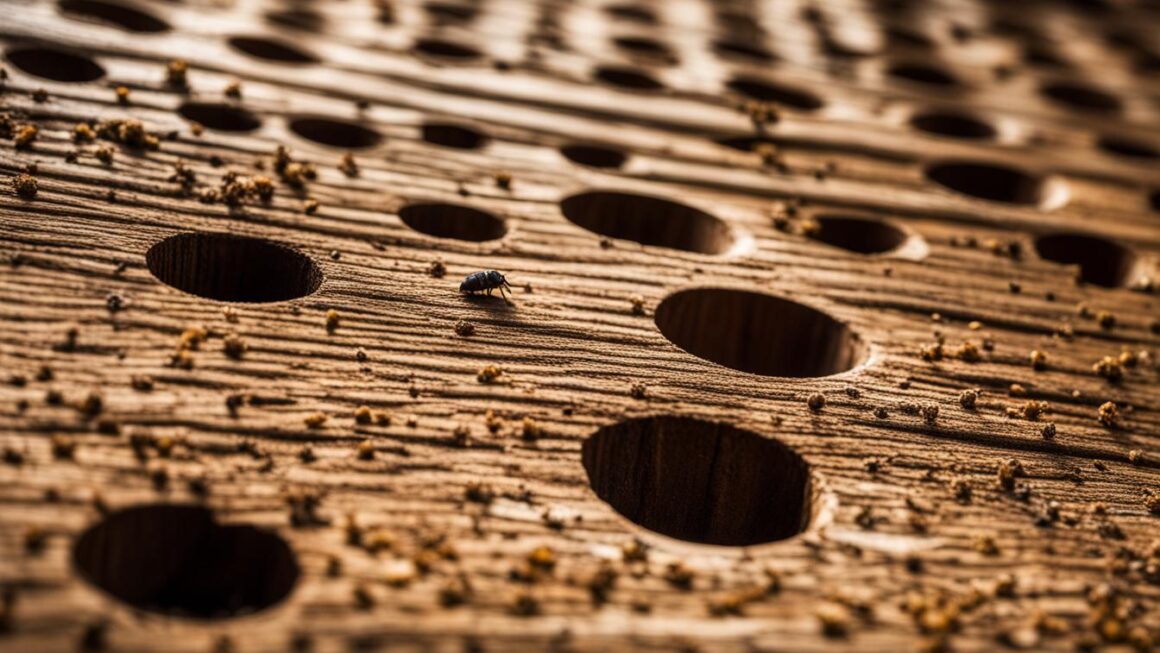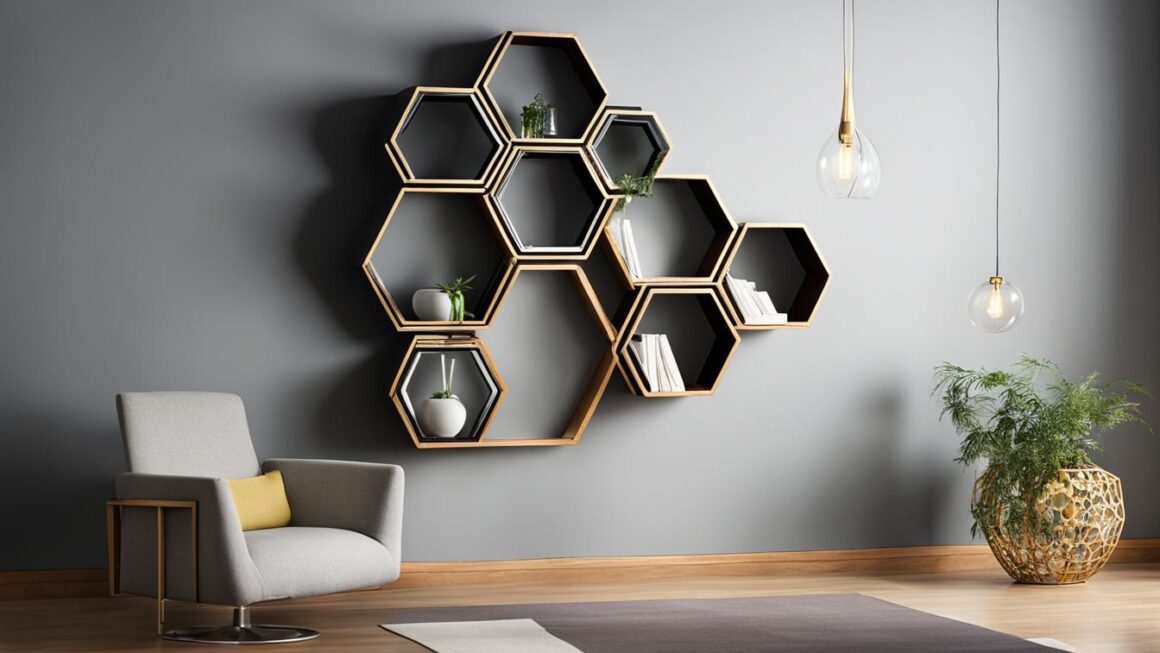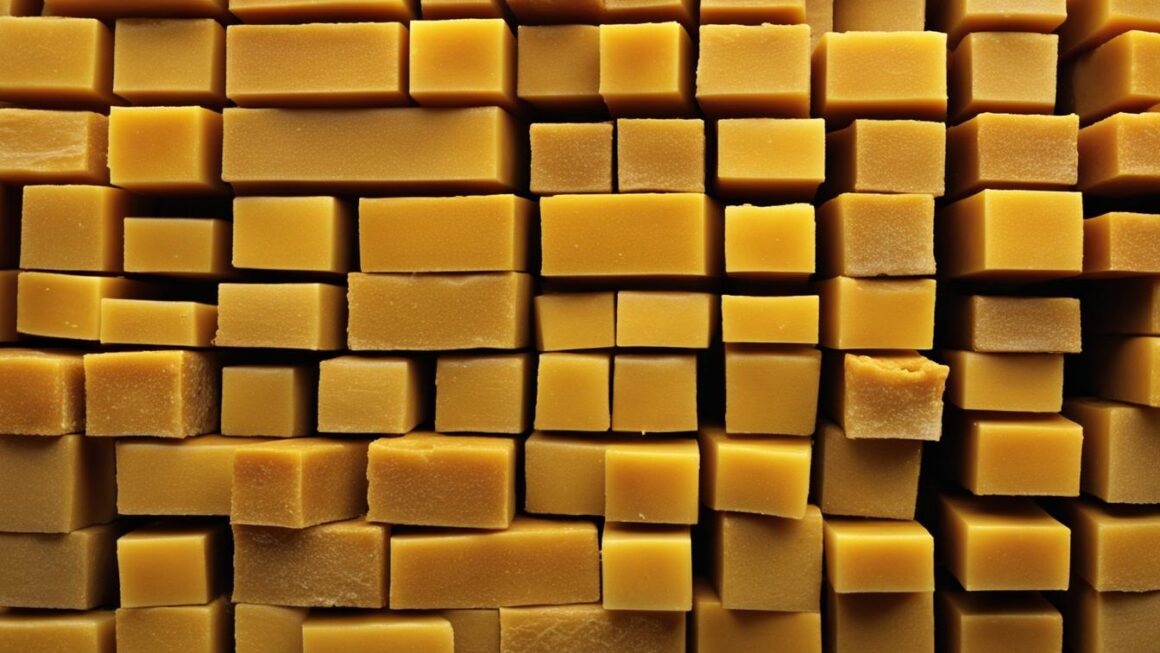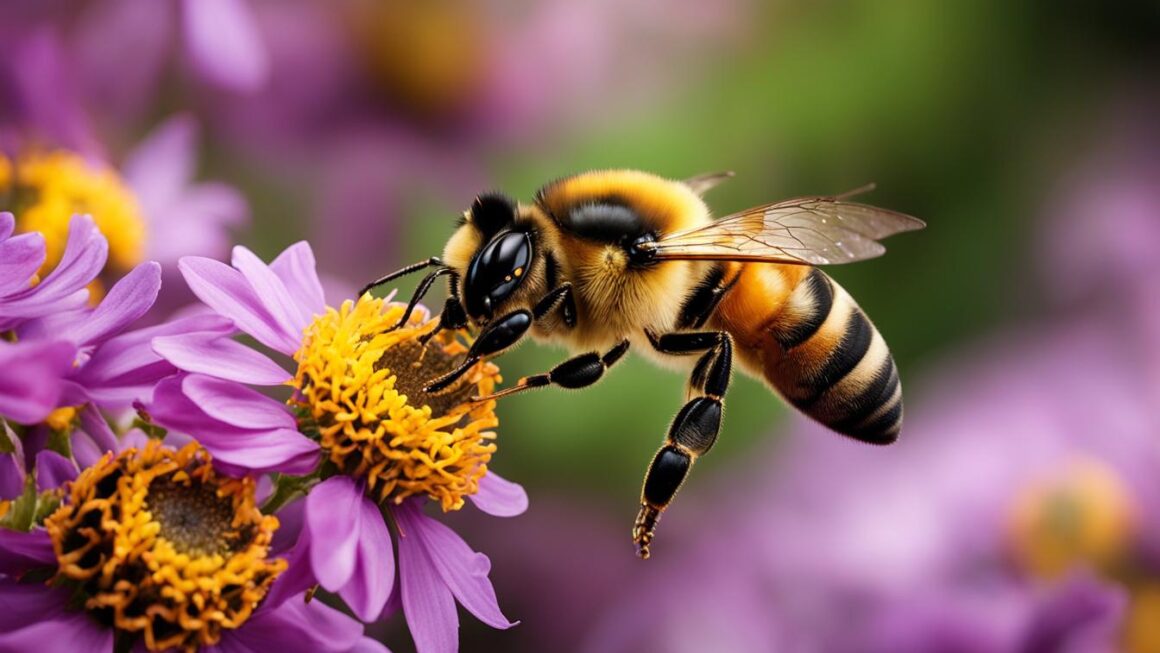Are you concerned about the presence of carpenter bee holes in your wooden structures? Carpenter bees, although often mistaken for bumblebees, can cause significant damage over time. In this guide, we will help you identify carpenter bee holes and provide treatment options to prevent further damage.
Key Takeaways:
- Carpenter bees can be identified by their round, smooth holes in wood and the absence of yellow markings on their abdomens.
- Carpenter bee damage can lead to structural issues if left untreated.
- Preventing carpenter bees involves sealing cracks, painting or staining wood, and keeping doors closed to deter their nesting.
- Regular inspection of wooden structures is important to detect carpenter bee holes and take necessary actions.
- Filling existing holes with metallic materials and regular maintenance can help prevent carpenter bee infestations.
Now, let’s dive deeper into the identification process of carpenter bees and the signs of infestation to effectively address this issue.
Carpenter Bee Identification
Carpenter bees are a species of bee that can be identified by their physical features. While they may resemble bumblebees, carpenter bees lack the yellow markings on their abdomens. They have smooth and shiny abdomens, making them distinct from other bee species. It’s important to note that carpenter bees can vary in appearance across different species.
One common type of carpenter bee is the Eastern carpenter bee, which has a black body with a patch of yellow hair on its thorax. Another species, such as the California and female valley carpenter bees, have more metallic and colorful bodies. These physical characteristics can help in identifying carpenter bees in their natural habitats.
Physical Features of Carpenter Bees
| Species | Physical Features |
|---|---|
| Eastern Carpenter Bee | Black body with a patch of yellow hair on the thorax |
| California and Female Valley Carpenter Bee | Metallic and colorful bodies |
By understanding these physical features, homeowners and pest control professionals can easily identify carpenter bees and take appropriate measures to control any potential infestations.
Signs of Carpenter Bee Infestation
Carpenter bees can be a nuisance and cause damage to wooden structures if left unchecked. Identifying the signs of a carpenter bee infestation is crucial in preventing further damage. Here are some common signs to look out for:
- Round, smooth holes in wood: One of the telltale signs of a carpenter bee infestation is the presence of round, smooth holes in wooden surfaces. These holes are typically about half an inch in diameter and serve as entrances to their nesting galleries.
- Hovering bees: Another indication of a carpenter bee infestation is the sight of bees hovering around wooden structures, especially near the entrance holes. Male carpenter bees are typically more territorial and will hover and fly near humans or other perceived threats.
Inspecting for carpenter bee holes regularly can help you catch an infestation early on and take necessary measures to address the problem. Here’s a simple step-by-step guide to inspecting for carpenter bee holes:
- Visual inspection: Carefully examine wooden surfaces, such as decks, porches, fences, and eaves, for any signs of round, smooth holes.
- Wood shavings: Look for piles of wood shavings or sawdust near the entrance holes. Carpenter bees push out excess wood shavings as they create their nesting galleries.
- Presence of bees: Observe if there are carpenter bees hovering around the wooden structures or entering and exiting the holes.
- Check for staining: Carpenter bee activity can cause staining on the wood surfaces due to their excrement. Look for any discoloration or dark patches.
Taking proactive steps to inspect for carpenter bee holes can help you identify infestations early and prevent further damage to your property. Sealing cracks and crevices in wooden structures, painting or staining the wood, and repairing screens can also help deter carpenter bees from entering your home.
| Signs of Carpenter Bee Infestation | Possible Remedies |
|---|---|
| Round, smooth holes in wood | Fill the holes with metallic materials like steel wool or tin foil |
| Hovering bees near entrance holes | Regularly inspect wooden surfaces and address any infestations promptly |
| Piles of wood shavings or sawdust | Remove the shavings and apply appropriate treatment |
| Staining on wood surfaces | Clean and treat the stained areas to prevent further damage |
Carpenter Bee Damage and Infestation
Carpenter bees can cause significant damage to wooden structures if their nesting habits are left untreated. The bees create smooth, round holes in the wood, which serve as entry points for their nests. Over time, the tunnels they excavate can weaken the structural integrity of the affected wood, leading to potential safety hazards. Additionally, the presence of carpenter bees can attract woodpeckers who feed on the bee larvae, further exacerbating the damage.
It is important to note that carpenter bees have a preference for soft, unpainted wood. However, they are also known to attack stained or painted wood when suitable nesting sites are scarce. Therefore, decks, fences, and other wooden structures are particularly prone to infestations. Regular inspection and maintenance of these areas are crucial in identifying early signs of carpenter bee activity and addressing any potential infestations.
To effectively manage and prevent carpenter bee infestations, it is recommended to take proactive measures. This includes sealing any cracks or crevices in wooden surfaces using a suitable sealant, as these gaps can provide entrance points for the bees. It is also advisable to paint or stain exposed wood surfaces, as the bees are less likely to attack treated wood. Additionally, keeping doors and windows closed can help minimize the likelihood of carpenter bees entering indoor spaces.
| Signs of Carpenter Bee Damage | Preventive Measures |
|---|---|
| Smooth, round holes in wood | Seal cracks and crevices |
| Wood dust near entrance holes | Paint or stain wooden surfaces |
| Weakened structural integrity of wood | Keep doors and windows closed |
| Woodpecker activity | Regular inspection and maintenance |
Carpenter Bee Habits and Galleries
Carpenter bees are solitary insects that exhibit unique habits when it comes to nesting and building galleries. Unlike bumblebees, they do not live in nests or colonies. Instead, female carpenter bees chew circular holes through wood to create individual galleries for their eggs and larvae to develop.
“Female carpenter bees chew circular holes through wood to make individual galleries for their eggs and larvae to develop.”
These galleries serve as protected spaces where the larvae can feed and mature before emerging as adult bees. The galleries are typically found in soft, unpainted wood, although some species may also attack stained or painted wood. Decks, fences, and other wooden structures are particularly prone to carpenter bee infestations.
Carpenter Bee Habits:
- Carpenter bees overwinter in abandoned nest tunnels and emerge in spring to feed on nectar.
- They mate and build galleries in which their eggs and larvae can develop.
- The female carpenter bees are responsible for creating the galleries by chewing circular holes through wood.
These habits, while fascinating, can also lead to structural damage if left untreated. It is important for homeowners to regularly inspect their wooden structures for signs of carpenter bee activity and take preventative measures to protect against infestations.
Where to Find Carpenter Bees
Carpenter bees can be found nesting in various locations, especially where there is soft, unpainted wood. These bees do not live in nests or colonies like other bee species. Instead, females drill circular holes into wood to lay their eggs and protect their larvae. Some common places to find carpenter bees include:
- Decks and porches
- Fences and railings
- Wooden furniture
- Sheds and barns
- Window frames and sills
Carpenter bees prefer wood that is weathered, untreated, and has minimal protective coatings. However, it’s important to note that certain species of carpenter bees may also target hardwood. So no matter the type of wood, it’s essential to be vigilant in inspecting and protecting wooden structures to prevent infestations.
When searching for carpenter bees, look for small, perfectly round holes with smooth edges. These holes are usually about 1/2 inch in diameter and may be accompanied by a pile of sawdust-like material called frass. Additionally, you may observe hovering bees near these holes as they enter and exit their nests.
Carpenter Bee Sting Facts
When it comes to carpenter bees, understanding their behavior and potential stings is essential for homeowners. Male carpenter bees, although territorial, do not possess a stinger and are harmless. They may hover closely to people, but their presence does not pose a sting threat. Female carpenter bees, on the other hand, have the ability to sting, but it is rare and typically requires provocation.
Female carpenter bees are primarily concerned with protecting their nests and offspring. If they feel threatened or believe their nest is in danger, they may resort to stinging as a defense mechanism. It is important to note that female carpenter bees are not aggressive by nature and will only sting when they perceive a direct threat.
To avoid carpenter bee stings, it is crucial to refrain from handling or squishing them. It is recommended to maintain a distance and allow these pollinators to go about their nesting activities undisturbed. By respecting their space and avoiding unnecessary contact, homeowners can reduce the risk of carpenter bee stings.
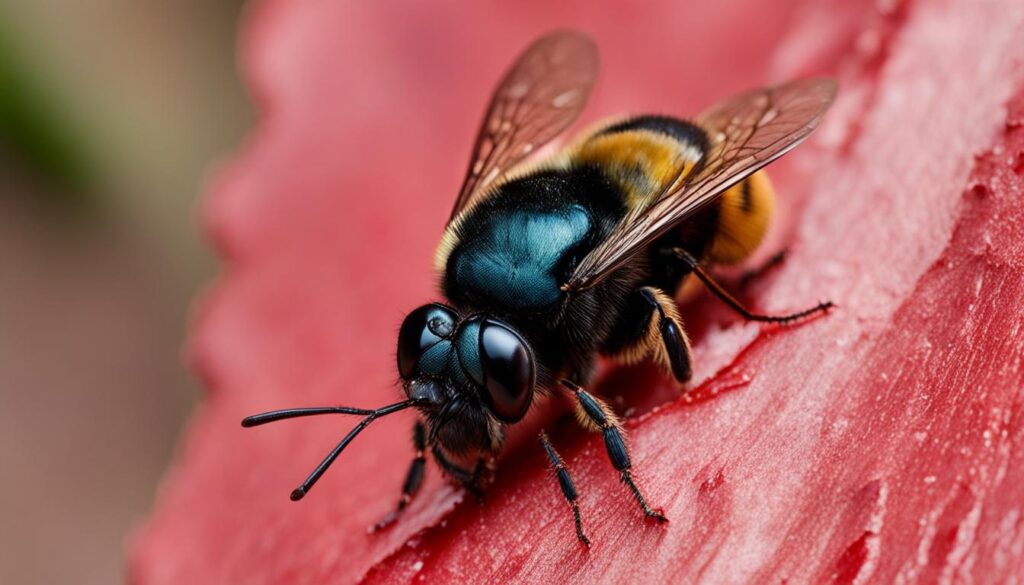
Quotes:
Male carpenter bees do not sting but can be territorial and hover closely to people.
Female carpenter bees can sting but only when provoked or if they perceive a direct threat to their nest.
Table: Comparison of Male and Female Carpenter Bees
| Aspect | Male Carpenter Bees | Female Carpenter Bees |
|---|---|---|
| Potential to Sting | No | Yes, but rare |
| Behavior | Territorial, may hover closely to people | Protective of nest, may sting when threatened |
Understanding the different behaviors and capabilities of male and female carpenter bees is essential for homeowners. By knowing that male carpenter bees do not sting and that female carpenter bees rarely sting unless provoked, individuals can coexist with these beneficial pollinators without unnecessary fear.
What Are Carpenter Bees?
Carpenter bees are a species of bees that belong to the Xylocopa genus. They are known for their unique nesting habits, which involve burrowing into natural, unfinished wood. These bees are often mistaken for bumblebees or called wood bees, wood boring bees, and even big black bees.
Unlike bumblebees, carpenter bees are solitary insects that do not live in nests or colonies. They overwinter in abandoned nest tunnels and emerge in spring to feed on nectar, mate, and build galleries. Female carpenter bees chew circular holes through wood to make individual galleries for their eggs and larvae to develop.
There are various types of carpenter bees found globally. They have smooth, shiny abdomens and can resemble bumblebees. Eastern carpenter bees have black bodies with a patch of yellow hair on their thorax. California and female valley carpenter bees have more metallic, colorful bodies.
| Type of Carpenter Bee | Physical Features |
|---|---|
| Eastern Carpenter Bee | Black bodies with a patch of yellow hair on their thorax |
| California Carpenter Bee and Female Valley Carpenter Bee | Metallic, colorful bodies |
Carpenter bees are attracted to soft, unpainted wood but may also attack stained or painted wood. Decks, fences, and other wooden structures are prone to infestations. It is important to identify and address carpenter bee activity to prevent structural damage and protect wooden structures.
Nesting Habits of Carpenter Bees
Carpenter bees drill circular holes into wood to create their nests, known as galleries. They use their mandibles to chew through the wood, creating holes that can be up to an inch deep in just a few days. It is important to note that they do not eat the wood but leave behind sawdust as a sign of their activity. Regular inspections and timely treatment can help prevent carpenter bee infestations and minimize damage to wooden structures.
How Carpenter Bees Drill Holes
Carpenter bees have a unique nesting process that involves drilling holes into untreated wood to create their galleries, where they lay their eggs and protect their larvae. Using their mandibles, carpenter bees chew through the wood, creating circular holes that can be up to an inch deep in just a few days. These holes have smooth edges and are typically free of sawdust, making them distinct from other types of damage.

The drilling process of carpenter bees is influenced by several factors. They are attracted to soft, unpainted wood, although they may also target stained or painted wood. The location of the holes can vary, but carpenter bees often prefer areas with direct sunlight, such as eaves, decks, and porch railings. Additionally, the presence of existing tunnels or galleries can attract new carpenter bees to establish their nests.
To deter carpenter bees from drilling holes in wooden structures, it is important to take preventative measures. Applying a protective finish, such as paint or stain, to exposed wood surfaces can discourage carpenter bees from nesting. Regularly inspecting and maintaining wooden structures can also help identify and address any early signs of infestation, preventing further damage.
The Nesting Process of Carpenter Bees
The nesting process of carpenter bees involves several stages. Female carpenter bees create galleries within the wood by chewing circular holes. They then deposit their eggs within individual cells and provide provisions for the larvae to feed on. The larvae develop inside the galleries and eventually emerge as adult bees.
| Stage | Description |
|---|---|
| Egg Laying | Female carpenter bees chew circular holes in wood to create galleries for egg deposition. |
| Larval Development | The eggs hatch into larvae, which feed on provisions left by the female bee and develop inside the galleries. |
| Pupal Stage | The larvae spin cocoons and enter the pupal stage, where they undergo metamorphosis. |
| Emergence | The adult bees emerge from the gallery, creating new holes to exit the wood. |
Understanding the nesting process of carpenter bees can help homeowners identify the signs of infestation and take appropriate measures to prevent further damage. By implementing proactive strategies and regular maintenance, the impact of carpenter bee drilling can be minimized.
Carpenter Bee Damage and Prevention
Carpenter bee damage can have significant consequences for homeowners, leading to structural issues and attracting other pests. To prevent carpenter bee infestations and minimize damage, it is crucial to take proactive measures. Here are some effective methods for carpenter bee damage prevention:
1. Fill Existing Holes
The first step in preventing carpenter bee infestations is to fill any existing holes in wooden structures. Use metallic materials like steel wool or tin foil to seal off the entrances and prevent bees from reentering. This not only stops further damage but also discourages other bees from establishing new nests.
2. Regular Maintenance
Maintaining wooden structures is key to deterring carpenter bees. Regularly inspect your property for any signs of wood damage or holes. Promptly repair any deteriorating or damaged wood and consider reinforcing vulnerable areas with additional protective coatings.
3. Sealing Cracks and Crevices
Carpenter bees are attracted to small cracks and crevices in wood, which they can use as entry points. Seal these gaps with caulk or wood putty to prevent bees from accessing the interior of wooden structures. Additionally, ensure doors and windows are properly sealed to minimize potential entry points.
Taking these preventive measures can help safeguard your home against carpenter bee damage. By filling existing holes, conducting regular maintenance, and sealing cracks and crevices, you can reduce the risk of infestations and protect your wooden structures.
| Prevention Methods | Description |
|---|---|
| Fill Existing Holes | Use metallic materials to seal off existing carpenter bee holes and prevent reentry. |
| Regular Maintenance | Inspect wooden structures regularly and repair any damage promptly. |
| Sealing Cracks and Crevices | Seal gaps and openings in wood to prevent carpenter bee entry. |
Are Carpenter Bees Dangerous?
Carpenter bees are generally not aggressive and rarely sting humans. Unlike their stinging counterparts, such as honeybees and wasps, male carpenter bees do not possess a stinger. However, it’s important to note that female carpenter bees have the potential to sting if they feel threatened or provoked. Although their stings are rare and typically mild, it is advisable to exercise caution and avoid handling or squishing carpenter bees.
While the immediate danger from carpenter bees may be minimal, their nesting habits can cause significant structural damage to homes and other wooden structures. Over time, the repetitive drilling of circular holes through the wood weakens the integrity of the affected areas. This can lead to structural issues that may require costly repairs if left unaddressed. The presence of carpenter bees can also attract other pests, such as woodpeckers and wasps, further exacerbating the potential for damage.
To prevent carpenter bee infestations and mitigate the risk of structural damage, proactive measures should be taken. Regular inspection of wooden structures for signs of carpenter bee activity, such as round holes with smooth edges, is crucial. Implementing preventive measures, such as filling existing holes with metallic materials like steel wool or tin foil, can deter carpenter bees from establishing nests. Additionally, maintaining and sealing cracks and crevices in wooden structures can help prevent their entry.
| Summary of Carpenter Bee Danger and Structural Damage |
|---|
| Carpenter bees are generally not aggressive but can sting if provoked. |
| Their nesting habits can cause significant structural damage to wooden structures over time. |
| Untreated carpenter bee infestations can attract woodpeckers and wasps. |
| Regular inspection and preventive measures are key to mitigating the risks. |
By acknowledging the potential dangers associated with carpenter bees and implementing effective prevention strategies, homeowners can safeguard their wooden structures and maintain a pest-free environment.
Conclusion
In conclusion, carpenter bee treatment and protecting wooden structures are crucial in preventing and addressing carpenter bee damage. Identifying carpenter bee holes by their circular shape, smooth edges, and absence of sawdust is the first step. Filling these holes with metallic materials, such as steel wool or tin foil, can help deter further nesting and infestation.
Regular maintenance of wooden structures, such as decks and porches, is essential to prevent carpenter bee activity. This includes sealing cracks and crevices, painting or staining wood, and repairing screens to keep these destructive pests at bay. By taking proactive measures, homeowners can safeguard their wooden structures from the structural damage caused by carpenter bees.
Remember, prompt action is necessary to address carpenter bee infestations as they can attract other pests like woodpeckers and wasps. By implementing effective treatment and prevention methods, you can protect your property and preserve the integrity of your wooden structures.
FAQ
What do carpenter bees look like?
Carpenter bees look similar to bumblebees but lack yellow markings on their abdomens. Eastern carpenter bees have black bodies with a patch of yellow hair on their thorax, while California and female valley carpenter bees have more metallic, colorful bodies.
How can I identify a carpenter bee infestation?
The most common sign of a carpenter bee infestation is the presence of round, smooth holes in wood. Homeowners should regularly inspect their property for these holes and hovering bees.
Can carpenter bee damage cause structural issues?
Yes, if left untreated, carpenter bee damage can cause structural issues over time. Larvae developing in tunnels can attract woodpeckers, leading to further damage.
What are some preventive measures against carpenter bees?
Preventing carpenter bees involves sealing cracks and crevices, painting or staining wood, and keeping doors closed to prevent them from entering the home.
Where do carpenter bees nest?
Carpenter bees do not live in nests or colonies. Females bore circular holes through soft wood to lay eggs and protect their larvae. These holes can be found in homes, fences, and other wooden structures.
Do carpenter bees sting?
Male carpenter bees do not sting but can be territorial. Female carpenter bees can sting, although it is rare and requires provocation.
What are carpenter bees?
Carpenter bees are a species of bees that belong to the Xylocopa genus. They are known for their unique nesting habits, which involve burrowing into natural, unfinished wood.
How do carpenter bees drill holes?
Carpenter bees love to make holes in untreated wood to create their nests, known as galleries. They use their mandibles to chew through the wood, creating holes that can be up to an inch deep in just a few days.
Can carpenter bee damage be prevented?
Yes, filling existing holes with metallic materials, regular maintenance of wooden structures, and sealing cracks and crevices can help prevent carpenter bee infestations.
Are carpenter bees dangerous?
Carpenter bees are generally not aggressive and rarely sting humans. However, their nesting habits can cause structural damage to homes and other wooden structures.

